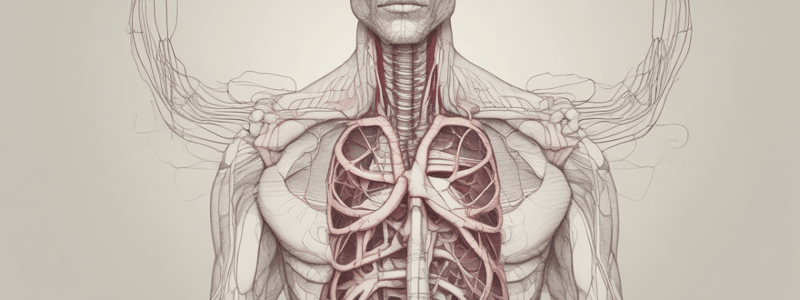Podcast
Questions and Answers
What is the effect of chronic hypoxia on pulmonary vessels?
What is the effect of chronic hypoxia on pulmonary vessels?
- Widespread vasodilation
- Increased hydrostatic pressure
- Decreased oncotic pressure
- Widespread vasoconstriction (correct)
What is the primary function of the lymphatic system in the lungs?
What is the primary function of the lymphatic system in the lungs?
- To decrease oncotic pressure
- To increase hydrostatic pressure
- To increase pulmonary resistance
- To drain fluid from the interstitial space (correct)
What is the effect of gravity on pulmonary vessels in the upright position?
What is the effect of gravity on pulmonary vessels in the upright position?
- Decreased hydrostatic pressure on vessels in the lower part of the lung
- No effect on pulmonary vessels
- Increased hydrostatic pressure on vessels in the lower part of the lung (correct)
- Increased hydrostatic pressure on vessels in the upper part of the lung
What is the approximate blood flow to the coronary circulation during heavy exercise?
What is the approximate blood flow to the coronary circulation during heavy exercise?
What is a characteristic feature of coronary arteries?
What is a characteristic feature of coronary arteries?
What is the consequence of obstruction in the coronary circulation?
What is the consequence of obstruction in the coronary circulation?
What is the main function of the bronchial circulation in the lungs?
What is the main function of the bronchial circulation in the lungs?
What is the characteristic of pulmonary vessels that helps to facilitate high volume of blood?
What is the characteristic of pulmonary vessels that helps to facilitate high volume of blood?
What is the optimal ventilation/perfusion (V/Q) ratio in the lungs?
What is the optimal ventilation/perfusion (V/Q) ratio in the lungs?
What is the purpose of hypoxic vasoconstriction in the lungs?
What is the purpose of hypoxic vasoconstriction in the lungs?
What is the characteristic of the capillaries in the lungs that facilitates gas exchange?
What is the characteristic of the capillaries in the lungs that facilitates gas exchange?
What is the result of chronic hypoxia in the lungs?
What is the result of chronic hypoxia in the lungs?
What is the pressure range in the pulmonary arteries?
What is the pressure range in the pulmonary arteries?
How many alveoli are present in the lungs?
How many alveoli are present in the lungs?
Flashcards are hidden until you start studying
Study Notes
Lungs and Circulation
- Lungs have dual supply, comprising bronchial and pulmonary circulations.
- Bronchial circulation supplies oxygen and nutrients to the lungs, while pulmonary circulation carries deoxygenated blood away from the right ventricle (RV) and oxygenated blood back to the left atrium (LA).
Bronchial Circulation
- Perfuses the respiratory tract up to the level of terminal bronchioles.
- Bronchial arteries arise from the aorta, and bronchial veins anastomose, bringing deoxygenated blood to pulmonary veins with slight mixing.
- Pressure in bronchial arteries is equal to systemic pressure.
Pulmonary Circulation
- The right and left ventricles have the same cardiac output (CO), requiring the entire CO to be oxygenated in the lungs.
- Special adaptations facilitate the high volume of blood and promote efficient gas exchange.
Pulmonary Circulation Adaptations
- To facilitate high volume of blood:
- Low pressure system with mean arterial pressure of 12-15 mmHg, mean capillary pressure of 9-12 mmHg, and mean venous pressure of 5 mmHg.
- Thin vascular walls and high compliance.
- Low resistance due to shorter and wider pulmonary vessels, capillaries running in parallel, and relatively fewer smooth muscle cells on arterioles.
- To promote efficient gas exchange:
- Branching structure provides a large surface area with 300 million alveoli.
- Short diffusion distance with alveoli and capillaries consisting of one layer of epithelium (~0.3 μm thickness).
- High density of capillaries with alveoli always close to capillaries.
- Hypoxic vasoconstriction promotes optimal ventilation/perfusion (V/Q) ratio of ~0.8-1.0.
Problems due to Hypoxic Vasoconstriction
- Chronic hypoxia leads to widespread vasoconstriction of pulmonary vessels, increasing pulmonary resistance and causing chronic pulmonary hypertension.
- Reasons for chronic hypoxia include high altitude and lung disease (e.g., emphysema).
Lymphatic System and Fluid Balance
- The mean filtration pressure at the pulmonary capillaries is +1 mmHg.
- Lymphatic system drains fluid in interstitial space, preventing fluid build-up.
- Imbalance in hydrostatic pressure or oncotic pressure can lead to pulmonary oedema due to fluid pooling around alveolar sacs.
- Left ventricular heart failure or mitral valve stenosis can cause pulmonary oedema.
Low Pressure Pulmonary Vessels and Gravity
- In the upright position, there is greater hydrostatic pressure on vessels in the lower part of the lung, causing fluid to pool at the bottom of the lung.
- Apical capillaries open during increased CO (e.g., exercise).
Coronary Circulation
- Resting coronary blood flow is 70-80 ml min-1 gram-1, increasing to 300-400 ml min-1 gram-1 during heavy exercise.
- Coronary arteries are intramural, compressed during systole, and perfused during diastole.
- Structural adaptations include high capillary density, continuous production of nitric oxide (NO) as a potent vasodilator, and reactive hyperaemia.
- These are end arteries with few or no anastomoses, making them prone to atheromas and obstruction, leading to ischaemia and infarction.
Studying That Suits You
Use AI to generate personalized quizzes and flashcards to suit your learning preferences.




